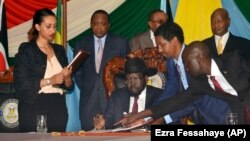South Sudan, the world’s newest country and one of its least developed, faces many humanitarian challenges. Today, it suffers in the world’s worst food security crisis, one caused primarily by man-made violence.
More than two decades of north-south conflict followed by factional fighting that erupted almost two years ago have further weakened an already fragile nation and undermined its ability to protect and feed its people.
The South Sudanese conflict has been particularly difficult on the civilian population. Thousands of people have been killed and more than 2.2 million driven from their homes. More than 600,000 have fled to neighboring states. Nearly 4.6 million, or 40 percent of the population, face acute hunger, particularly those living in the most conflict-affected areas of Unity, Upper Nile and Jonglei states.
Still, there is hope. In late August, the heads of the two warring parties signed a peace agreement that could bring an end to the fighting and set the country on a road to recovery.
In view of this positive development, the United States has announced an additional $80 million in humanitarian assistance for the people of South Sudan, specifically aimed at helping South Sudanese refugees. This brings the total U.S. assistance since the start of the conflict to over $1.3 billion.
The funding will aid those most in need, including internally displaced persons, refugees seeking asylum in South Sudan, and those South Sudanese who are living as refugees in neighboring nations.
The United States urges all signatories of the peace agreement to uphold their obligations to the people of South Sudan, and to allow immediate, full and unconditional humanitarian access to all populations in need in all areas of South Sudan. They must also ensure the safety and security of civilians, humanitarian workers, and humanitarian supplies. There is a long road ahead, and this is the first step.

















